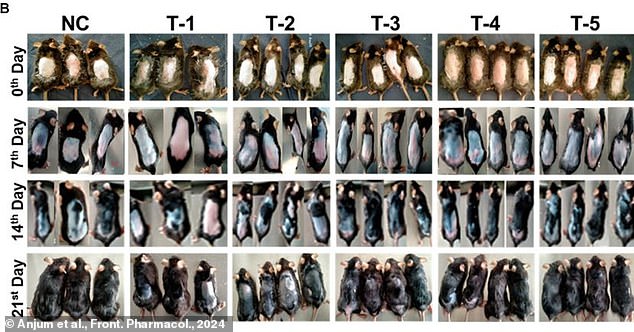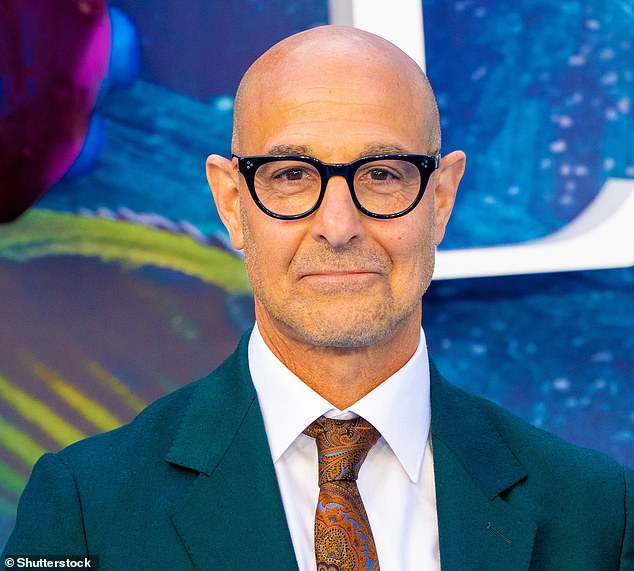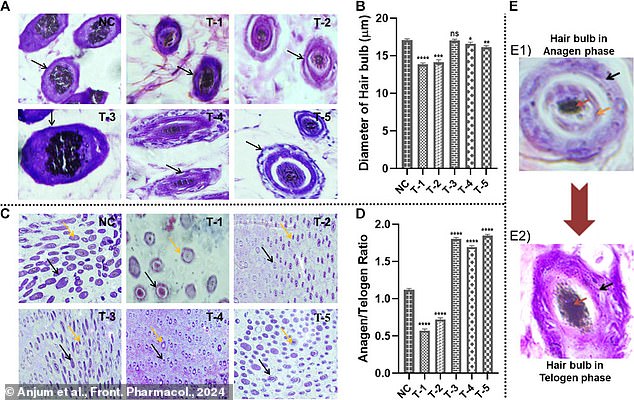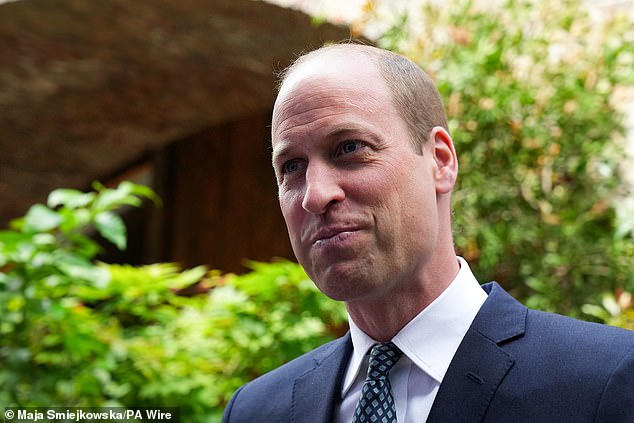The fear of going bald is something that weighs on the minds and scalps of millions of men around the world.
But if you’re anxiously checking your hairline, there’s finally good news: Scientists have found a potential cure for male pattern baldness.
Researchers from the University of Sheffield and COMSATS University in Pakistan have discovered that a sugar that occurs naturally in our bodies can stimulate hair growth in mice.
The sugar, 2-deoxy-D-ribose (2dDR), was as effective at restoring hair in bald rodents as the commercially available drug minoxidil, also known as Rogaine.
Professor Sheila MacNeil, from the University of Sheffield, said: “This could offer another approach to treating this condition which can affect men’s self-image and confidence.”
Baldness affects around half of all men in the world, including William, Prince of Wales (pictured), but scientists now say there may be a cure.
The researchers had not originally set out to find a cure for baldness, but were investigating whether the sugar 2dDR could help improve wound healing.
When applied to the skin in gel form, the sugar triggered increased blood vessel growth, which they hoped would make the cuts close faster.
However, they soon noticed that the mice’s hair grew back much faster in the areas around the wound where the gel had been applied.
Intrigued, the research team decided to conduct an experiment to determine whether 2dDR could have an effect on male pattern baldness.
Mice were treated with testosterone to induce “testosterone-induced hair loss,” similar to male pattern baldness in humans.
The mice were then shaved and treated with 2dDR, minoxidil, or a combination of both.

Researchers found that a natural sugar called 2-deoxy-D-ribose could promote hair growth in mice. Mice in the T3 and T5 cells were treated with this sugar and experienced a significant improvement in hair growth.

This sugar gel promoted 80 to 90 percent of hair growth in mice with male pattern baldness, presenting a potential treatment for men like John Travolta (pictured) who suffer from hair loss.
The researchers found that after 20 days of treatment, both the sugar gel and minoxidil had promoted 80 to 90 percent of hair growth in mice with male pattern baldness.
However, the combination of both treatments did not produce significant improvements.
Professor MacNeil says: “Our research suggests that the answer to treating hair loss could be as simple as using a natural deoxyribose sugar to increase blood supply to hair follicles and stimulate hair growth.”
Male pattern baldness, or androgenic alopecia, is thought to affect between 40 and 50 percent of men worldwide.
The condition is caused by a combination of genetic factors and sex hormone levels that gradually lead to permanent loss of hair follicles on the head.
Other research has recently suggested that the body’s “built-in stress response” may lead to delayed hair growth and hair loss.
A follicular cell can become stressed, for example, as it ages and becomes less able to produce hair properly, which slows growth.

By promoting blood flow to the hair follicles, researchers found that the sugar gel promoted the growth of thick, long hair (labeled T-3 and T-5).

Today, bald men like Stanley Tucci (pictured) can use minoxidil or finasteride to treat their hair loss.
And when the mechanism is activated excessively, the hair follicle can even die and stop any future growth.
However, as Professor MacNeil points out, “There are currently only two FDA-approved drugs to treat it.”
Patients may use the topical treatment minoxidil, sold as Rogaine, which can be slow and does not work for everyone suffering from hair loss.
Those who do not see improvements with minoxidil can also take the oral medication Finasteride, sold as Propecia, which works by decreasing the flow of testosterone.
However, it must be taken continuously once started and may be associated with serious side effects such as erectile dysfunction, testicular pain, reduced libido and depression.
Researchers hope their breakthrough with 2dDR sugar gels could provide a natural and safer alternative to these treatments.

Researchers hope their treatment could offer a natural alternative that promotes healthy blood vessel recovery (pictured) rather than affecting sex hormones.

Researchers say more research is needed but sugar gel could be a cheap, stable and safe way for men like Dwayne ‘The Rock’ Johnson (pictured) to regain lost hair.
The sugar 2dDR is produced naturally in the body as one of the building blocks of our DNA, helping to form the deoxyribose part of deoxyribonucleic acid (DNA).
And, rather than altering the level of sex hormones like finasteride does, the treatment simply works by increasing the amount of blood that can reach the hair follicles.
In tests, researchers found that this treatment caused individual hair follicles to grow long, thick, healthy hairs.
Professor Muhammed Yar from COMSATS University in Pakistan says: ‘This pro-angiogenic deoxyribose sugar is naturally produced, inexpensive and stable.
‘This makes it an attractive candidate to explore further in the treatment of hair loss in men.’

